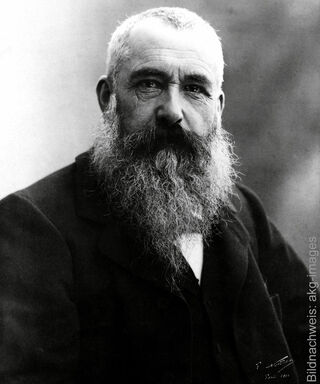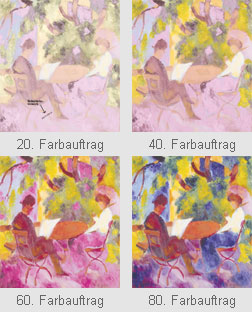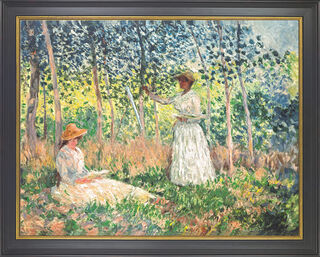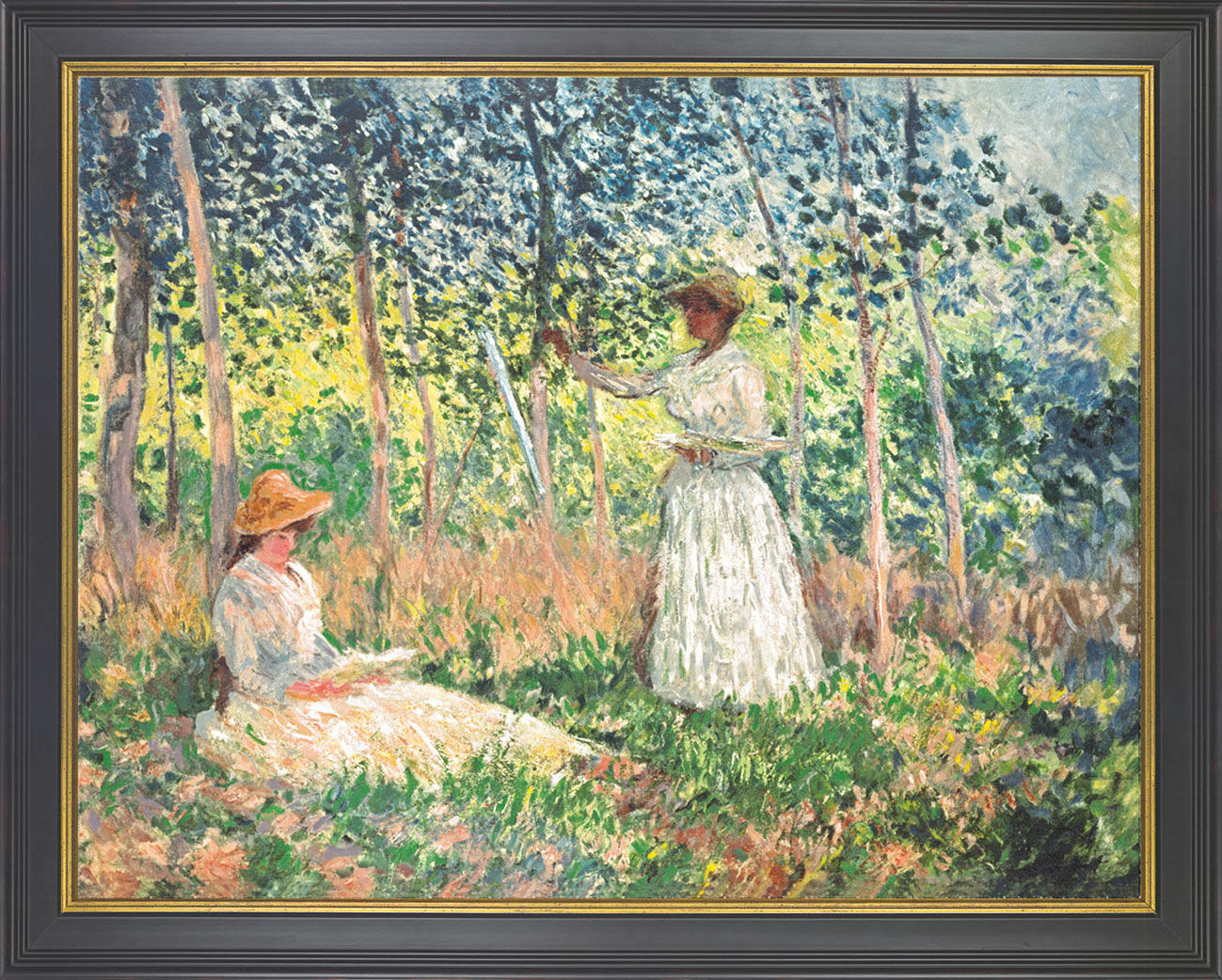Picture "Suzanne and Blanche Hoschedé Reading and Painting" (1890), framed


Picture "Suzanne and Blanche Hoschedé Reading and Painting" (1890), framed
Quick info
limited, 950 copies | original Dietz replica | oil on canvas | on stretcher frame | framed | size approx. 69.5 x 87.5 cm (h/w)
Detailed description
Picture "Suzanne and Blanche Hoschedé Reading and Painting" (1890), framed
Artistic family: Monet's stepdaughters
From the 1980s onwards, Claude Monet led a highly "modern" family life, which today Germans would probably describe as "patchwork". The widowed father of two sons found support through his second wife Alice Hoschedé, who initially cared for Jean and Michel Monet in Paris. In 1880, she and her six children of her first marriage, which officially lasted until 1891, moved in with Monet in Vétheuil and later in Giverny.
Monet's "Suzanne and Blanche Hoschedé Reading and Painting" shows two of Alice's daughters. Both of them remained attached to art: Suzanne by marrying a local artist and Blanche by being trained as a painter by her stepfather - quite successfully. In 1897, she married her stepbrother Jean and, after his death, provided for the ageing master in Giverny.
Original: 1890, oil on canvas, private collection.
Original Dietz replica. Oil on canvas in 92 colours. Limited edition of 950 copies. Each canvas replica is stretched on a stretcher frame like the original so you can re-stretch the canvas as room temperature and humidity fluctuate. Framed with a dark real wood strip. Size incl. frame approx. 69.5 x 87.5 cm (h/w).

About Claude Monet
1840-1926
The art of Claude Monet is the epitome of Impressionism. During his long life as a painter, he was tirelessly searching for new ways to depict the variability of light and colour in many various atmospheric variations and at different times of the day.
Monet was born in Paris, but grew up in Le Havre, on the Normandy coast, where his father ran a small grocery shop. He made his early artistic attempts with caricatures but then switched to open-air painting. Light pastel tones found their way onto his canvases. His paintings were repeatedly rejected by the official Paris Salon, but Monet and his friends Auguste Renoir and Alfred Sisley were not discouraged. On their joint excursions to Fontainebleau, they created magnificent fresh paintings in the open air that left the strict academic rules further and further behind.
However, severe financial crises hit Monet and his pregnant beloved Camille. During the Franco-Prussian War, Monet fled to London with his young family. After the war, they settled in Argenteuil. This small town outside Paris, picturesquely situated along the Seine, became the centre of attraction for a whole series of Impressionist painters: Edouard Manet, Gustave Caillebotte, Camille Pissarro, Auguste Renoir and Alfred Sisley met there to capture their impressions on canvas. In the group's first independent exhibition, a painting by Monet entitled "Impression. Sunrise" gave the art movement its name.
After Camille's death, Monet moved to Giverny with his second wife Alice. Here he was able to realise his lifelong dream of having his own garden, designed by himself: The flowering garden with its Japanese bridges and ponds full of water lilies inspired Monet constantly to create new, ever larger paintings showing the changing plant life as an overwhelming decorative harmony of nature.
This estate, which was bequeathed by Monet's son to the Academié des Beaux-Art in 1966 and is open to the public through the "Claude Monet Foundation" since 1980, was an inexhaustible source of inspiration for him. Today, the garden in Giverny is a destination valued many art lovers. Anyone who visits it feels immediately transported into the artist's pictorial world. In spring, colourful blossoms are all over the place, and while looking at the real water lily ponds that Monet painted over and over again, visitors are amazed at how precisely he captured the scenery, despite all his artistic idiosyncrasies. "On my garden I work continuously and with love, most of all I need flowers, always, always. My heart is always in Giverny. A separation from Giverny would hit me hard ... never again would I find such a beautiful place." And he never had to separate with his garden; Monet died in his beloved Giverny on 5 December 1926.
Monet has been called the inventor of colourful dreams beyond the visible. But he was much more, always seeking to realise his idea of painting in the open air - en plein air. For his painting, the decisive factor was always how he sees, not what he sees.
Günter Dietz developed a revolutionary method for the authentic reproduction of paintings, where not the usual printing inks are used, but the same original colours used by the artist. Depending on the artist's painting technique, up to 140 (!), different paint applications need to be applied in order to achieve a perfect replica of the original that also tangibly reproduces the "relief" and pastosity of colour composition.
Here are the examples of 'Couple at the Garden Table' by August Macke:

Furthermore, the same material as the original, such as reproduction on canvas, paper, wood, copper, parchment is always used.
The result is a perfect, gridless reproduction that comes very close to the original in expressiveness and effect. Even museum specialists often can not distinguish the replica from the original. Therefore, a special security note must be added, which is visible only under X-rays.
The edition of most Dietz replicas is limited, usually to 950 copies. Each canvas replica is stretched onto a frame as the original, so you can retighten the canvas in case of fluctuations in room temperature and humidity. A high-quality solid wood strips round off every Dietz replica.
Numerous masterpiece paintings of Rembrandt, Caspar David Friedrich, Claude Monet, Gustav Klimt and various others have been recreated by the "Dietz Offizin". Famous modern artists such as Pablo Picasso, Salvador Dalí, Max Ernst, Friedensreich Hundertwasser, Joan Miró and Marc Chagall have used this method developed by Günter Dietz in order to have replicas of their works produced.
Press comments:
"The Dietz System provides images as good as the originals. What the electronics did with the invention of Hi-Fi and stereo for music playback - here the graphic technology made up for visual art." (Die Zeit, German newspaper)
"In theory, there is no difference between the original and the Dietz replica. They should not be called reproductions, but facsimiles." (Newsweek, US-American news magazine)
"For art printers all over the world remains unrealizable to this day, what Dietz only managed with the help of printing technology: The perfect reproduction of painted works." (Der Spiegel, German news magazine)
Depiction of typical scenes from daily life in painting, whereby a distinction can be made between peasant, bourgeois and courtly genres.
The genre reached its peak and immense popularity in Dutch paintings of the 17th century. In the 18th century, especially in France, the courtly-galant painting became prominent while in Germany the bourgeois character was emphasised.
A true-to-the-original reproduction of an artwork in the same size and with the best possible material and colour uniformity.
The mould is usually taken directly from the original so that the replication reproduces even the finest details. After casting the replication, using the most appropriate method, the surface is polished, patinated, gilded or painted according to the original.
A replication of ars mundi is a recognizable copy of the original.


